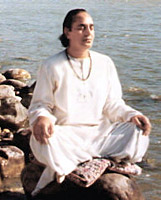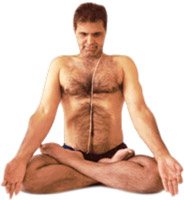 The word YOGA comes from the root Yuj which means to join, and in its spiritual sense, it is that process by which the human spirit is brought into near and conscious communion with, or is merged in, the Divine Spirit.
The word YOGA comes from the root Yuj which means to join, and in its spiritual sense, it is that process by which the human spirit is brought into near and conscious communion with, or is merged in, the Divine Spirit.
There are four main forms of Yoga, according to one school of thought, namely Mantra Yoga, Hatha Yoga, Laya Yoga and Raja Yoga; Kundalini Yoga is really Laya Yoga. There is another classification: Jnana Yoga, Raja Yoga, Laya Yoga, Hatha Yoga and Mantra Yoga. This is based on the idea that there are five aspects of spiritual life:-Dharma, Kriya, Bhava, Jnana and Yoga; Mantra Yoga being said to be of two kinds according as it is pursued along the path of Kriya or Bhava. There are seven Sadhanas of Yoga, namely Sat-Karma, Asana, Mudra, Pratyahara, Pranayama, Dhyana and Samadhi, which are cleansing of the body, seat postures for Yoga purposes, the abstraction of the senses from their objects, breath-control, meditation, and ecstasy.
Kundalini And Yoga
Hatha Yoga builds up its philosophy around Kundalini and the methods adopted in it are different from Tantrik Sadhana. Hatha Yoga seeks to awaken Kundalini through the discipline of the physical body, purification of Nadis and controlling the Prana. It tones up the entire nervous system through a number of physical poses called Yoga Asanas, and brings it under the conscious control of the Yogi. Through Bandhas and Mudras it controls the Prana, regulates its movements and even blocks and seals it without allowing it to move, through Kriyas it purifies the inner organs of physical body and, finally, through Pranayama it brings the mind itself under the control of the Yogi. Kundalini is made to go upwards towards Sahasrara through these combined methods.
 Raja Yoga mentions nothing about Kundalini, but propounds a still subtle, higher path, philosophical and rational, and asks the aspirant to control the mind, to withdraw all the senses and to plunge in meditation.Raja Yoga teaches a technique with eight limbs, appealing to the heart and intellect of aspirants. It advocates moral and ethical development through its Yama and Niyama, helps the intellectual and cultural development through Svadhyaya or study of holy Scriptures, satisfies the emotional and devotional aspect of human nature by enjoining to surrender oneself to the will of the Creator, has an element of mysticism by including Pranayama also as one of the eight limbs and finally, prepares the aspirant for unbroken meditation on the Absolute through a penultimate step of concentration. Neither in philosophy nor in its prescription of methods of Raja Yoga mentions about Kundalini, but sets the human mind and Chitta as its targets to be destroyed as they alone make the individual soul to forget its real nature and brings on it birth and death and all the woes of phenomenal existence.
Raja Yoga mentions nothing about Kundalini, but propounds a still subtle, higher path, philosophical and rational, and asks the aspirant to control the mind, to withdraw all the senses and to plunge in meditation.Raja Yoga teaches a technique with eight limbs, appealing to the heart and intellect of aspirants. It advocates moral and ethical development through its Yama and Niyama, helps the intellectual and cultural development through Svadhyaya or study of holy Scriptures, satisfies the emotional and devotional aspect of human nature by enjoining to surrender oneself to the will of the Creator, has an element of mysticism by including Pranayama also as one of the eight limbs and finally, prepares the aspirant for unbroken meditation on the Absolute through a penultimate step of concentration. Neither in philosophy nor in its prescription of methods of Raja Yoga mentions about Kundalini, but sets the human mind and Chitta as its targets to be destroyed as they alone make the individual soul to forget its real nature and brings on it birth and death and all the woes of phenomenal existence.



